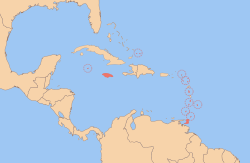
Back Westindīegena Geþoftscipe ANG اتحاد جزر الهند الغربية Arabic Vest-Hind Federasiyası Azerbaijani باتی هیند آدالاری فدراسییاسی AZB Федэрацыя Вест-Індыі Byelorussian ওয়েস্ট ইন্ডিজ ফেডারেশন Bengali/Bangla Západoindická federace Czech Westindische Föderation German Ομοσπονδία Δυτικών Ινδιών Greek Federacio de Karibaj Insuloj Esperanto
West Indies Federation | |
|---|---|
| 1958–1962 | |
| Motto: "To dwell together in unity" | |
| Anthem: "A Song for Federation" (proposed) | |
 | |
| Status | Federation of British colonies |
| Capital | |
| Common languages | |
| Demonym(s) | West Indian |
| Government | Federal parliamentary constitutional monarchy |
| Queen | |
• 1958–1962 | Elizabeth II |
| Governor-General | |
• 1958–1962 | Lord Hailes |
| Prime Minister | |
• 1958–1962 | Grantley Herbert Adams |
| Legislature | Federal Parliament |
• Upper Chamber | Senate |
• Lower Chamber | House of Representatives |
| Historical era | Cold War |
• Established | 3 January 1958 |
• Disestablished | 31 May 1962 |
| Currency | BWI dollar (XBWD) |
| Calling code | +1 (809) |
The West Indies Federation,[1][2] also known as the West Indies,[3][4] the Federation of the West Indies[5] or the West Indian Federation,[6][7][8] was a short-lived political union that existed from 3 January 1958 to 31 May 1962. Various islands in the Caribbean that were part of the British Empire, including Trinidad and Tobago, Barbados, Jamaica, and those on the Leeward and Windward Islands, came together to form the Federation, with its capital in Port of Spain, Trinidad and Tobago. The expressed intention of the Federation was to create a political unit that would become independent from Britain as a single state[9] — possibly similar to Canada, the Federation of Australia, or the Federation of Rhodesia and Nyasaland. Before that could happen, the Federation collapsed due to internal political conflicts over how it would be governed or function viably. The formation of a West Indian Federation was encouraged by the United Kingdom, but also requested by West Indian nationalists.[10]
The territories that would have become part of the Federation eventually became the nine contemporary sovereign states of Antigua and Barbuda, Barbados, Dominica, Grenada, Jamaica, Saint Kitts and Nevis, Saint Lucia, Saint Vincent and the Grenadines, and Trinidad and Tobago; with Anguilla, Montserrat, the Cayman Islands, and the Turks and Caicos Islands becoming British overseas territories. British Guiana and British Honduras held observer status within the West Indies Federation.
- ^ "The West Indies Shipping Corporation Act" (PDF). Archived from the original (PDF) on 2012-09-16. Retrieved 2017-06-30.
- ^ Archibald, Charles H. (1962). "The Failure of the West Indies Federation". The World Today. 18 (6): 233–242. JSTOR 40393409. Archived from the original on 2023-04-16. Retrieved 2023-04-12 – via JSTOR.
- ^ "UF Digital Collections". ufdc.ufl.edu. Archived from the original on 2023-03-24. Retrieved 2023-04-12.
- ^ "West Indies (Federation) Order in Council 1957" (PDF). Archived (PDF) from the original on 2017-08-26. Retrieved 2017-06-30.
- ^ States, United (April 12, 1961). "United States Defense Areas in the Federation of the West Indies: Agreement, with Annexes, Between the United States of America and the Federation of the West Indies Signed at Port of Spain February 10, 1961 with Memorandum of Understanding. Agreed Minute, and Related Exchange of Notes Between the British Parliamentary Under-Secretary of State for the Colonies and the Representative of the United States of America". U.S. Government Printing Office – via Google Books.
- ^ "Jamaica's Brexit: Remembering the West Indian Federation". Archived from the original on 2018-04-03. Retrieved 2017-06-30.
- ^ Oostindie, Gert; Klinkers, Inge (April 12, 2003). Decolonising the Caribbean: Dutch Policies in a Comparative Perspective. Amsterdam University Press. ISBN 978-90-5356-654-1 – via Google Books.
- ^ Era Bell Thompson, "Black Leaders of the West Indies", Ebony, October 1967.
- ^ Ayearst, Morley; Lowenthal, David (June 1961). "The West Indies Federation: Perspectives on a New Nation". Political Science Quarterly. 76 (2): 291. doi:10.2307/2146224. JSTOR 2146224. Archived from the original on 2022-02-12. Retrieved 2021-02-21.
- ^ Nelson, Renee A. (4 July 2020). "The West Indian Press and Public: Concepts of Regionalism and Federation, 1944–1946". Journal of Caribbean History. 54 (1): 82–105. doi:10.1353/jch.2020.0000. ISSN 0799-5946. S2CID 226463649.
© MMXXIII Rich X Search. We shall prevail. All rights reserved. Rich X Search

